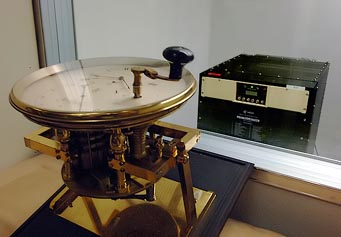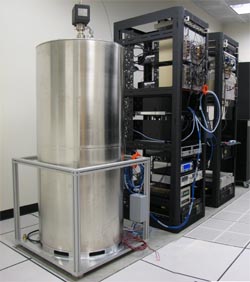Here's a question that's sure to stump the crowd at your next holiday party: "How many hours are there in a day?"
Most everyone would instinctively answer, "It's 24, of course!" But that's not quite right.

Precision time, then and now: an antique chronometer and modern atomic clock at the U.S. Naval Observatory in Washington, D.C.
U.S. Naval Observatory
More precisely, we Earthlings currently enjoy 24.0000003 hours in an average day. That tiny additional fraction at the end is a consequence of changing the official definition of a second (in 1967) from an astronomical standard to atomic time. So time is no longer reckoned by Earth's rotation. Instead, atomic clocks around the world are synced using Coordinated Universal Time, or UTC.
Meanwhile, our planet's spin is gradually slowing down (thanks to tidal friction). So to keep UTC in close step with the turning of the Earth, every now and then officials at the International Earth Rotation and Reference Systems Service add a "leap second" to Universal Time — and we'll get our next one on New Year's Eve at 23:59:59 UT, which corresponds to 6:59:59 p.m. Eastern Standard Time.
I'm not sure where I'll be partying at that moment, but I'm glad to have the chance to whoop it up just a bit more as I ring in 2009.
A press release announcing the forthcoming time warp points out that this is the 24th leap second added since 1972, the previous one having been added at the end of 2005.

A view into one of two Rubidium Atomic Frequency Fountain clock chambers at the U.S. Naval Observatory's Master Clock Facility. The clock itself is the large metallic cylinder at left.
U.S. Naval Observatory
The U.S. Naval Observatory in Washington, D.C., which issued the announcement, is the world's leader in maintaining and correcting time standards. Just last month, for example, the observatory unveiled a new "master clock" facility. The new digs emphasize function over form. Storage vaults for the dozens of atomic clocks on site (about a third of those operating worldwide) maintain temperature to within 0.1°C and humidity to within 3%.
Among those ultraprecise timekeepers is a next-generation Rubidium Atomic Frequency Fountain clock. The rubidium atoms inside oscillate more than six billion times per second, and the frequency stability can be maintained to fractions of a trillionth of a second. I'm told that a wristwatch version is not yet available.
Precision timekeeping for terrestrial and astronomical purposes can be quite involved; when your time permits, check out our online introduction to the subject. For the gory details on how the need for leap seconds is computed, click here.
Meanwhile, if all you want is the current time, the USNO offers several online methods to get it. And, notes Geoff Chester, the observatory's public-affairs officer, "We even continue to provide dial-up modem time, provided you can get to a command prompt and a phone dialer. The numbers are 202-762-1594 (Washington) and 719-567-6743 (Colorado)" — settings are 1200 baud, N81.
"And, yes, you can still call us for the time," Chester adds. Use 202-762-1401 and 202-762-1069 (Washington) or 719-567-6742 (Colorado).
Finally, time signals are continuously broadcast over shortwave radio at frequencies of 2.5, 5, 10, 15, and 20 megahertz. (As Steve Allen comments below, these broadcasts are a service of the National Institute of Standards and Technology.)
Observers "hear" in the Northeast usually dial in to the Canadian's time-signal broadcast at 7.335 megahertz, which is broadcast via the national Research Council's shortwave station CHU, located near Ottawa. But now we've gotten word that CHU will swtich to a new frequency, 7.850 megahertz.
There's just one small problem: the switchover occurs at 00:00 UT on January 1st. So if you tune in on the old frequency, you'll hear the leap second tick by — and then the broadcast will go dead!
 6
6
Comments
Steve Allen
December 16, 2008 at 12:17 pm
There are two different US agencies responsible for legal time.
At the nanosecond level it is relevant to point out that the WWV radio transmissions from NIST are not the same time scale as the USNO master clock. NIST follows different criteria than USNO for keeping the frequency stability of their clocks.
A description of the criteria used at NIST is here
http://tf.nist.gov/timefreq/general/pdf/1804.pdf
The GPS time scale is based on the USNO clocks.
You must be logged in to post a comment.
Tom Whiting
December 19, 2008 at 11:43 am
Long time ago, I read where the Earth is slowing down
something like a couple of milli-sconds per year due to
lunar Tidal forces. If that is so, how come this coming
Leap Second is the 24th one added? Seems to me, if we
just slow down like one second per century on average, how
come so many leap seconds have been needed the past
several decades? Something doesn't...add up correctly.
Is this another Madoff scam?
Clear Skies,
Tom Whiting
Erie, PA
You must be logged in to post a comment.
Fred from Laurel, Md
December 20, 2008 at 8:38 am
Tom/Erie PA -- The slowdown of Earth's rotation can be expressed as msec/day/yr, that is, each year, the day lengthens by x msec. (Sorry, I don't know exactly what x is.) So if the original definition of the second is based on the actual day length in 1901 (do I recall correctly?), a clock running at exactly that rate back then, would accumulate extra time at a rate of exactly 0 initially, but at an increasing rate as the years roll by. This would lead to leap seconds not being needed for quite a while at first, but then they would be needed more and more frequently with the passing years. Once the day gets to be 24h+0.001sec, a leap second would occur about every 1000 days; then when it becomes 24h+0.002sec, a leap second would occur about every 500 days; when it reaches 24h+0.003sec, a leap second would occur about every year; etc. This even trend gets complicated, though, by internal movement of mass within the planet, so it can't be predicted precisely, which is why they have to watch it (someone has to!) constantly to determine when the adjustment is needed.
You must be logged in to post a comment.
Michael Coyle
December 20, 2008 at 10:33 am
The principal reason for leap seconds is because atomic clocks run too fast! When the atomic second was defined, it was reckoned to be equal to mean solar time based on the Earth's rotation in 1901 but it's now widely recognised that in fact the atomic second actually corresponds to a second of mean solar time in the year 1830 when the Earth was rotating faster than it was in 1901 and (relatively) much faster than it is now. This means that even if the Earth's rotational speed was to stabilise at today's rate, we'd still need leap seconds because the atomic clocks are running faster than mean solar time.
You must be logged in to post a comment.
Gaurav Karunakar
December 27, 2008 at 6:55 am
How do they adjust leap seconds? By stopping the clocks for one second? How practical is it for ordinary citizens?
You must be logged in to post a comment.
FER
December 27, 2008 at 4:13 pm
G.K. asked: "How do they adjust leap seconds? By stopping the clocks for one second? How practical is it for ordinary citizens?"
Imagine a clock that consists of software designed to count the number of "ticks" emitted once per second by some device. To insert a leap second, all you have to do is tell the clock's software to count "58, 59, 60, 0, 1, 2,..." when it reaches the insertion point instead of "58, 59, 0, 1, 2,...". So it's really not hard at all to insert a leap second. It's different only in scale from a leap day. As for ordinary clocks owned by "ordinary" citizens, the majority that we use are now set remotely. Your computer will pick up the change the first time it re-synchronizes after the leap second. For other clocks, it will simply change the known error (e.g. yesterday three seconds fast... today four seconds fast). A "known error" is no error at all.
You must be logged in to post a comment.
You must be logged in to post a comment.